-
MacEachern, Ian (b.1942, Glace Bay, Nova Scotia)
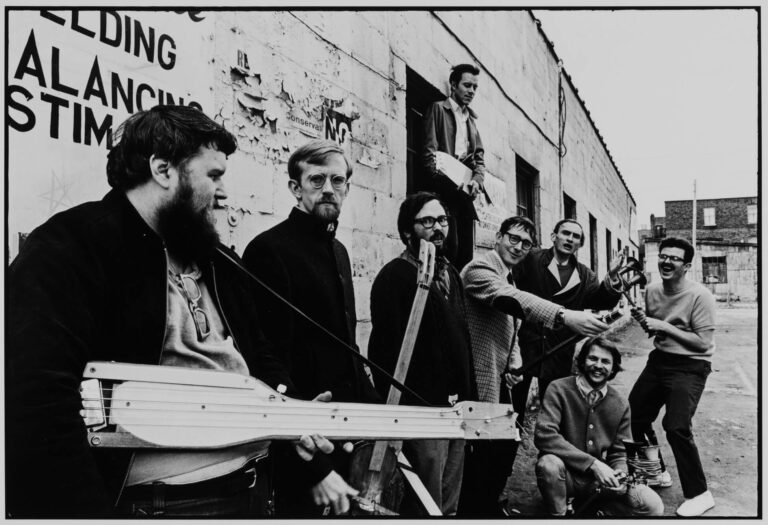
MacEachern worked as a freelance photographer from the 1960s, often focusing on architecture and urban renewal, in Saint John, New Brunswick, and in Toronto and London, Ontario. In 1966, a local urban development organization commissioned him to study the dilapidated houses in the north end of Saint John. The images were not used as documents by the commission; however, they were published in artscanada the following year. In London, he photographed members of the regional art scene, including Murray Favro and Greg Curnoe.
Image: Ian MacEachern, Hugh McIntyre, Art Pratten, John Clement, Murray Favro, Archie Leitch, Bill Exley, Greg Curnoe, John Boyle, Nihilist Spasm Band, York Hotel, London, ON, 1968/2000, gelatin silver print, 27.9 x 35.6 cm, Museum London.
For further reading, see:
“Grass Roots Art in Canada.” artscanada 26 (December 1969): 4–21.
Leroux, John, and Ian MacEachern. The Lost City: Ian MacEachern’s Photographs of Saint John. Fredericton: Goose Lane Editions, 2018.

-
Macnamara, Charles (1881, Quebec City–1944, Arnprior, Ontario)
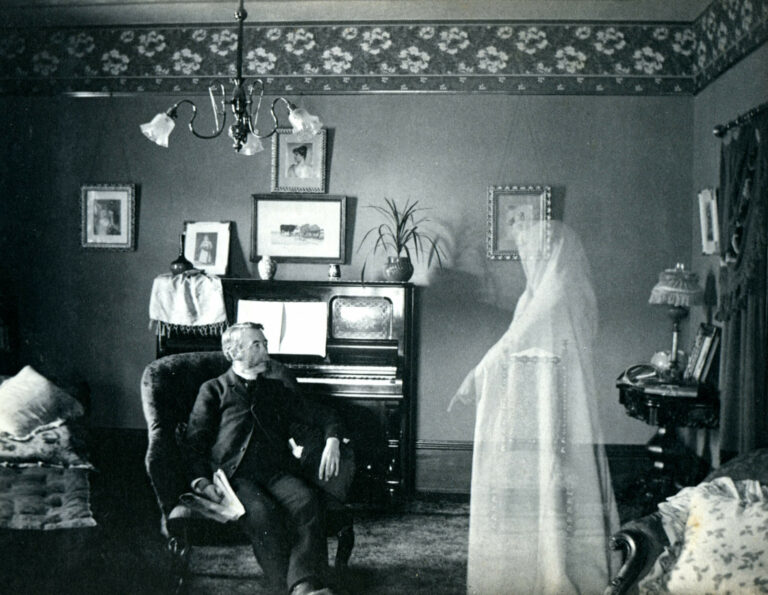
Macnamara lived and worked in Arnprior, Ontario. He was involved with the Pictorialist movement and experimented with alternative photographic processes and the popular Victorian genre of spirit photography. Macnamara photographed the natural life in the area in great detail, reflecting his personal interests as an amateur entomologist and naturalist. His photographs also provide an important record of the early lumber industry in Canada, as he worked in that industry for decades.
Image: Charles Macnamara, Richard Macnamara and “ghost,” 1894, Arnprior & McNab / Braeside Archives.
For further reading, see:
Sutnik, Maia-Mari, et al. Photographs by Charles Macnamara and M.O. Hammond: Pictorial Expressions in Landscape and Portrait. Toronto: Art Gallery of Ontario, 1989.

-
Man, Felix H. (1893, Freiburg, Breisgau, Germany–1985, London)
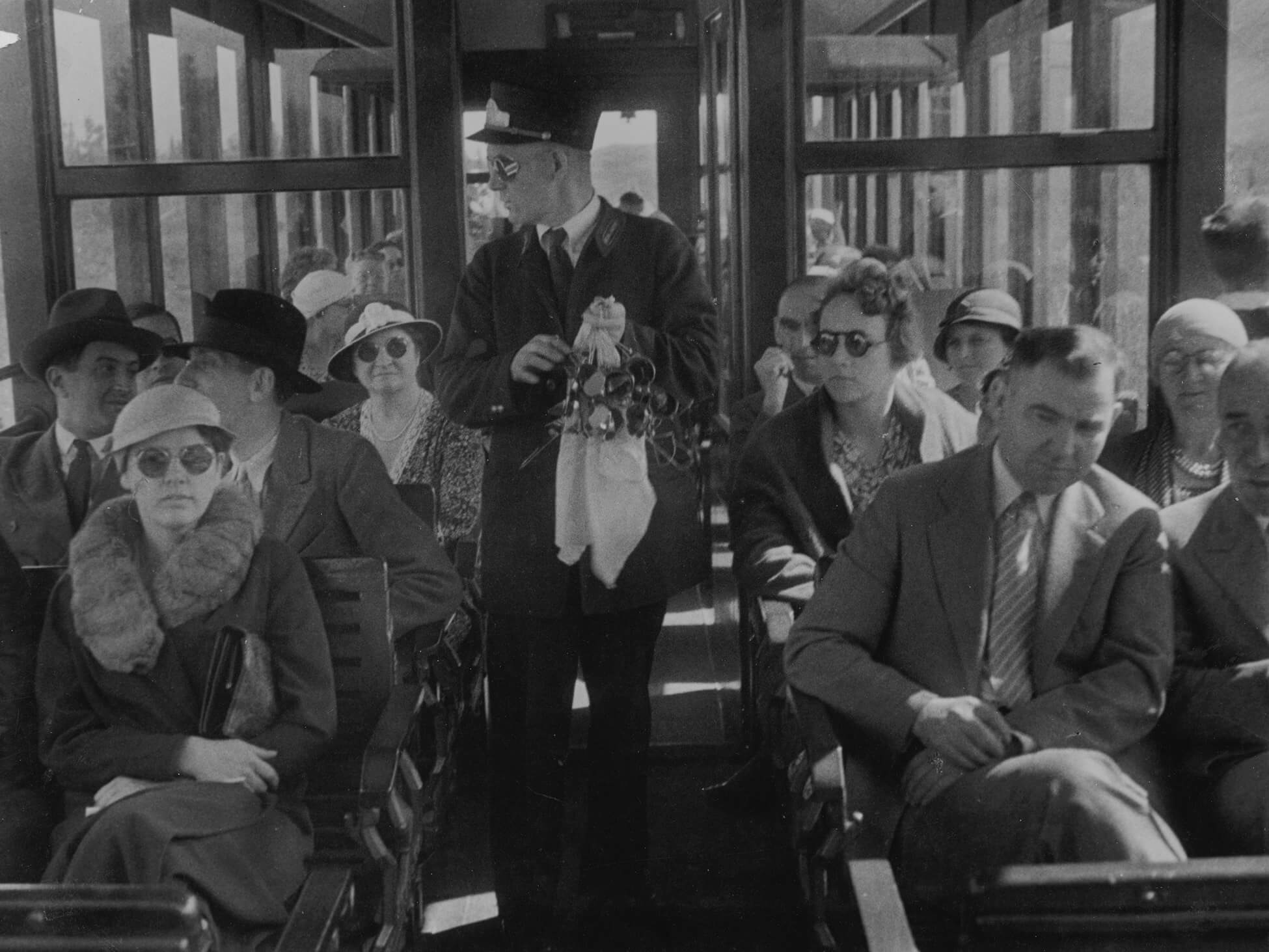
Man, born Hans Felix Sigismund Baumann, was a German photographer who contributed to the development of modern photojournalism through his picture stories. In the 1930s Man immigrated to Britain, where he contributed to the Picture Post. In 1933 he spent about six months in Canada on assignment for the leading German magazine Berliner Illustrirte Zeitung, or BIZ. Man travelled across the country and took hundreds of photographs, many of which present a romanticized view. A selection of his work is in the Library and Archives Canada collection.
Image: Felix H. Man, C.P.R. (Canadian Pacific Railway)—Open observation car, the porter is selling goggles against the dust of the engine, 1933, gelatin silver print, 22.4 x 29.6 cm, Library and Archives Canada, Ottawa.
For further reading, see:
Man, Felix H. Man with Camera: Photographs from Seven Decades. New York: Schocken Books, 1984.
Schwartz, Joan. “Felix Man’s ‘Canada’: Imagined Geographies and Pre-Texts of Looking.” In The Cultural Work of Photography in Canada, edited by Carol Payne and Andrea Kunard, 3–22. Montreal and Kingston: McGill-Queen’s University Press, 2011.

-
Manning, Jimmy (b.1951, Kimmirut, Nunavut)
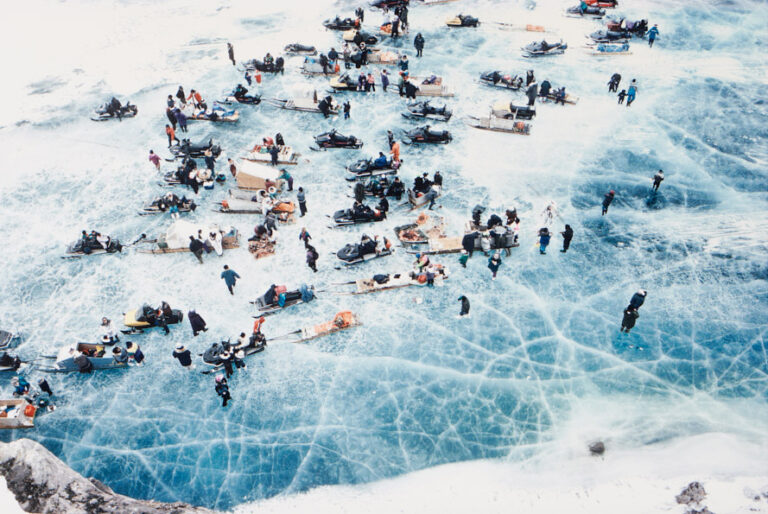
Manning is an artist based in Kinngait (formerly known as Cape Dorset), Nunavut, whose practice includes drawing, printing, carving, and photography. He turned to photography in 1968, and his work focuses on Arctic community life, including candid images of family, friends, and landscapes. Manning was an art buyer for the West Baffin Eskimo Co-operative (WBEC, now Kinngait Studios) in the 1970s before working as the manager of its printmaking studio. He often photographed the artists who worked there. Manning is the grandson of photographer Peter Pitseolak.
Image: Jimmy Manning, Gathering/Spring Fishing (detail), 1999, colour photograph, 76 x 114 cm, Canada Council Art Bank, Ottawa.
For further reading, see:
Brown, Beth. “Past and Future at the West Baffin Eskimo Co-op.” Up Here, April/May 2019. uphere.ca/articles/past-and-future-west-baffin-eskimo-co-op.
“Jimmy Manning.” Inuit Art Quarterly, n.d.
www.inuitartfoundation.org/profiles/artist/Jimmy-Manning.

-
Mansaram, Panchal (1934, Mount Abu, Rajasthan–2020, Hamilton, Ontario)
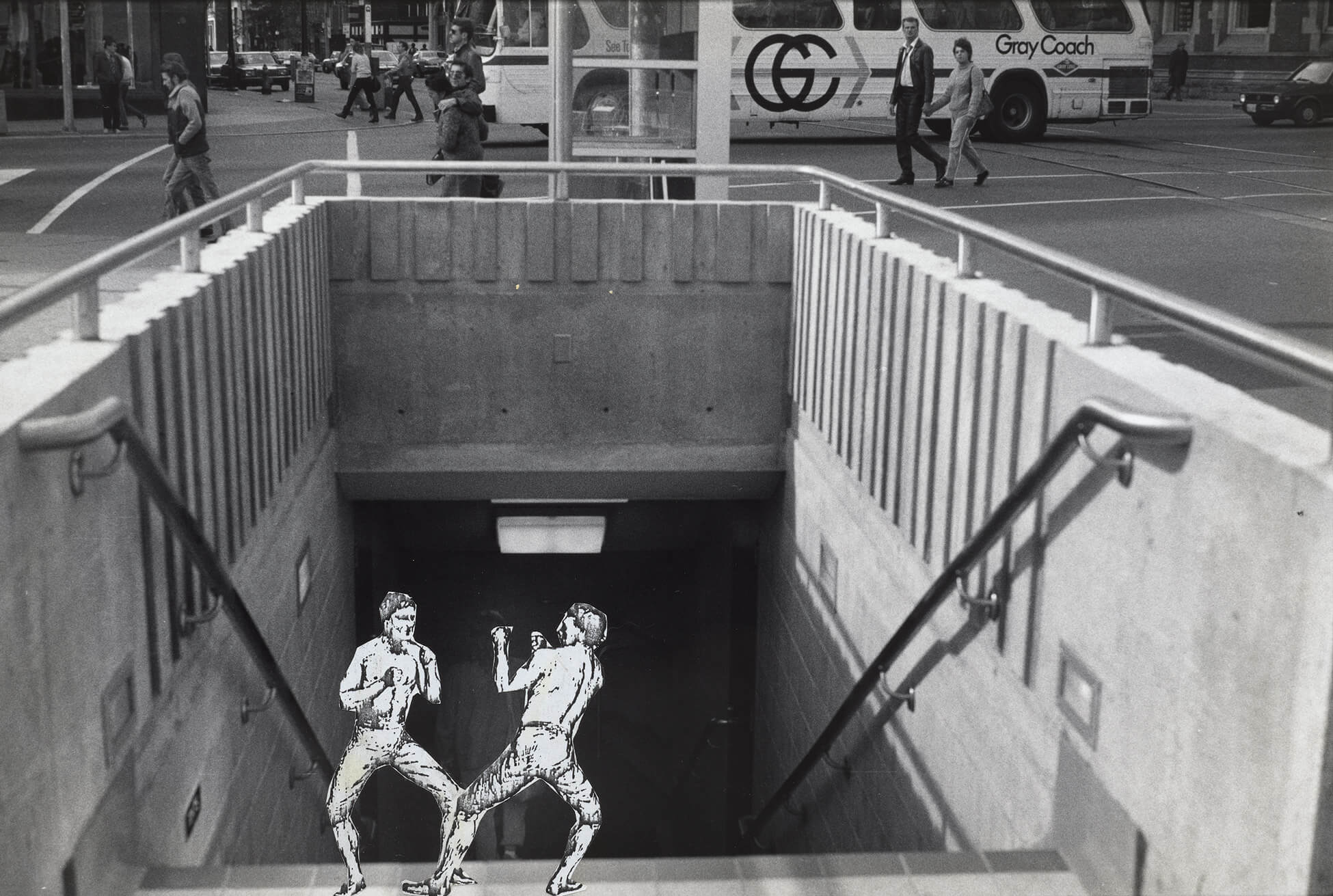
P.Mansaram (who preferred to write his name without a space) graduated from art school in Bombay (Mumbai) and furthered his studies in the Netherlands before immigrating to Canada in 1966. In the Netherlands he became interested in collage as a way to bring together disparate media from paint, print, and photography, as well as images drawn from Indian and Western visual cultures. In Canada, P.Mansaram forged a collaborative relationship with media theorist Marshall McLuhan and produced a range of innovative collage work before it became more widely used among Canadian artists. Until 1989 P.Mansaram taught art in Hamilton, while continuing to exhibit in Canada and in India. His work is in the collection of the Royal Ontario Museum.
Image: P.Mansaram, Boxers at the Entrance of a Toronto Subway, 1976, paper cut-out on a gelatin silver print, 28 x 35.5 cm, Royal Ontario Museum, Toronto.
For further reading, see:
Battacharyya, Monolina. “P.Mansaram.” Building Cultural Legacies Hamilton, 2019. buildingculturallegacies.ca/artist/p-mansaram/.
Dewan, Deepali. “P.Mansaram: A Canadian Artist in and of the World.” Canadian Art, March 16, 2021. canadianart.ca/essays/p-mansaram/.
Kuskis, Alexander. “Mansaram and Marshal McLuhan: Collaboration in Collage Art.” Imaginations: Journal of Cross-Cultural Image Studies, December 6, 2017. dx.doi.org/10.17742/IMAGE.MA.8.3.3.

-
Max, John (1936, Montreal–2011, Montreal)
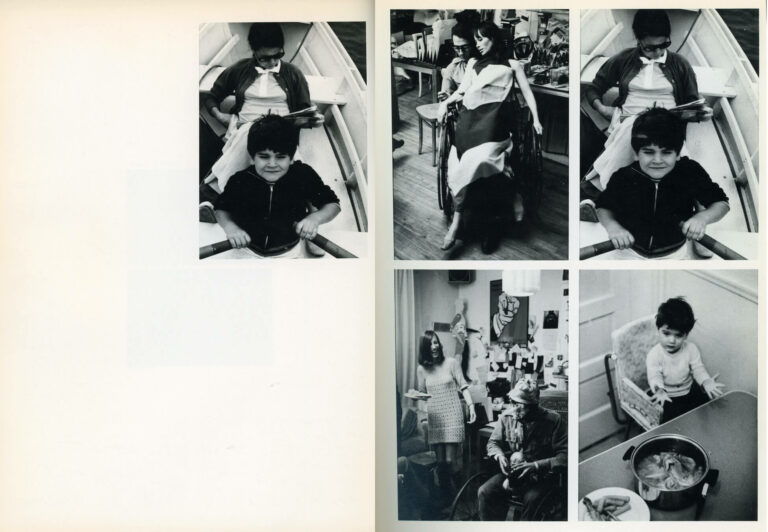
Max was an editorial photographer in the 1950s and 1960s and worked with the National Film Board’s Still Photography Division. In the late 1960s he turned his focus to artistic work. Max’s best-known artwork is the 1972 series Open Passport, where he organized 162 of his personal photographs into a poetic narrative that explores human intimacy.
Image: John Max, Double-page spread of Open Passport, 1973, offset lithography on paper, 28.5 x 44 cm, Collection of the Estate of John Max.
For further reading, see:
Hardy-Vallée, Michel. “The Photobook as Variant: Exhibiting, Projecting, and Publishing John Max’s Open Passport.” History of Photography 43, no. 4 (2019): 399–421.
Max, John. Open Passport: Photographs. Ottawa: National Film Board Photo Gallery, 1972.

-
McCall, Helen (1899, West Howe Sound, British Columbia–1956, Dollarton, British Columbia)
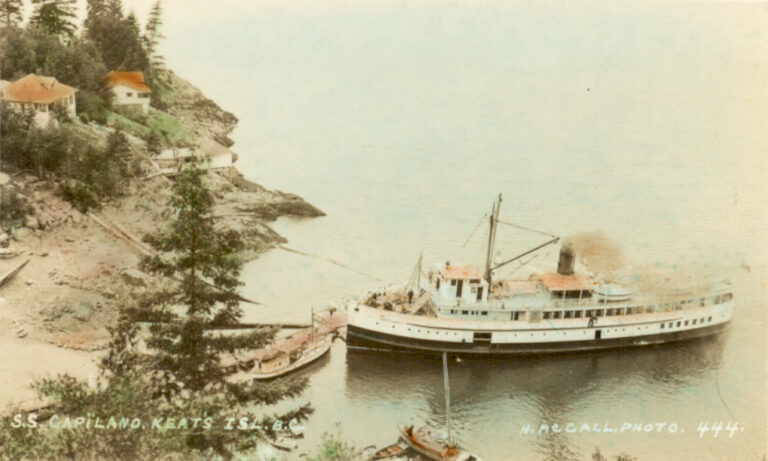
McCall was a professional photographer working in the southern mainland coast region of British Columbia in the 1920s and 1930s. She specialized in scenic views, which she sold as postcards to residents and tourists. McCall also photographed events and celebrations, such as regattas and weddings. Another aspect of her enterprise involved travelling to schools along the coast to produce class photos. Her work is in the collection of the Sunshine Coast Museum and Archives in Gibsons, B.C.
Image: Helen McCall, a colourized or tinted postcard photo of the Union Steamship Company vessel S.S. Capilano docked at Keats Island, 1930, postcard, Sunshine Coast Museum and Archives, Gibsons, British Columbia.
For further reading, see:
Cobb, Myrna, and Sher Morgan. Eight Women Photographers of British Columbia, 1860–1978. Victoria: B.C. Ministry of Labour and Camosun College, 1978, 40.

-
McDougall, Annie (1866, Trois-Rivières, Quebec–1952, Montreal)
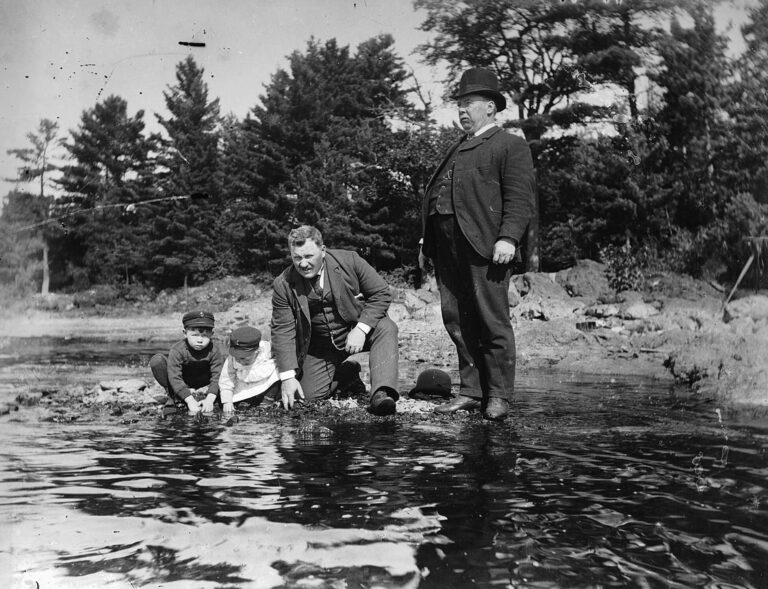
Before she began her almost five decades–long tenure as the librarian at the Fraser Institute in Montreal, McDougall was an avid amateur photographer. She bought one of the new hand-held cameras from William Notman in 1888 and turned the lens on her surroundings and extended family in Drummondville, Quebec. McDougall photographed her nieces and nephews, friends, landscapes, and domestic interiors with humour and a keen eye for unusual arrangements. The negatives her nephew donated to the McCord Museum provide an intimate woman’s perspective of late nineteenth-century middle-class life in Quebec.
Image: Annie McDougall, William, Jimmie, Ivan and Bruce Millar at St. Francis River, Drummondville, QC, 1888, silver salts on glass, gelatin dry plate process, 10 x 12 cm, McCord Stewart Museum, Montreal.
For further reading, see:
Fontein, Rosina. “Annie G. McDougall, Québec.” Canadian Woman Studies 2, no. 3 (1980): 11.
Jones, Laura. Rediscovery: Canadian Women Photographers, 1841–1941. London: London Regional Art Gallery, 1983.
Samson, Hélène. “Notman reçoit.” Continuité, no. 122 (Fall 2009): 45–49.

-
McEachern, Susan (b.1951, Wausau, Wisconsin)
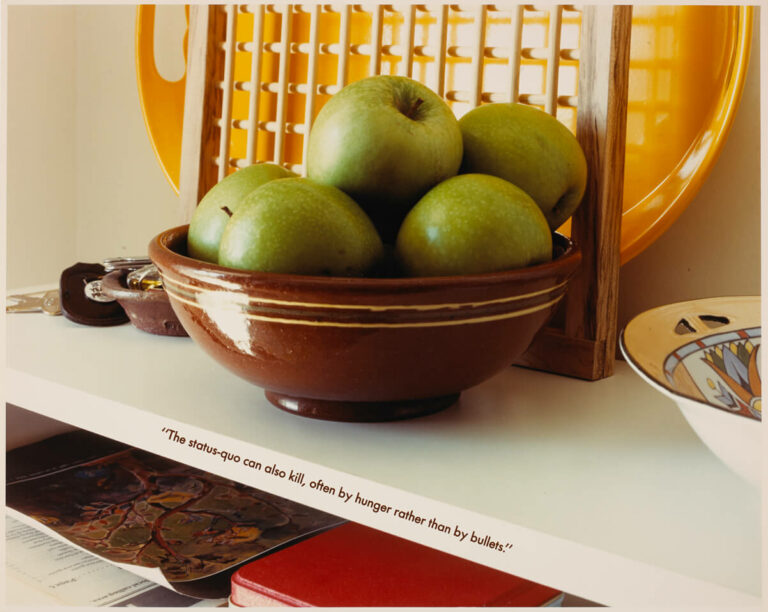
Since the 1980s, McEachern has investigated issues of gender, domesticity, and labour. Informed by feminist theory and taking her lived experience as a point of departure, her work comments on the social construction of identity and history. In series such as The Family in the Context of Childrearing, 1985, and On Living at Home, 1986–87, McEachern explores gender and the intersection of public and private space through closely cropped photographs combined with text. McEachern taught at Nova Scotia College of Art and Design/NSCAD University in Halifax from 1977 until her retirement in 2013.
Image: Susan McEachern, Part Four: The Outside World (detail), 1986–87, six chromogenic prints, 40.6 x 50.8 cm each, CMCP Collection, National Gallery of Canada, Ottawa.
For further reading, see:
Kunard, Andrea. Susan McEachern: Structures of Meaning. Ottawa: Canadian Museum of Contemporary Photography, 2004.
Fisher-Taylor, Gail. “At the Epicentre.” In 13 Essays on Photography, introduction by Geoffrey James, 144–160. Ottawa: Canadian Museum of Contemporary Photography, 1990.
Simon, Cheryl. “Domestic Subversion: Susan McEachern’s On Living at Home.” In Frame of Mind: Viewpoints on Photography in Contemporary Canadian Art, edited by Daina Augaitis, 36–47. Banff: Walter Phillips Gallery, 1993.

-
McKenzie, Murray (1927, Cumberland House, Saskatchewan–2007, Winnipeg)
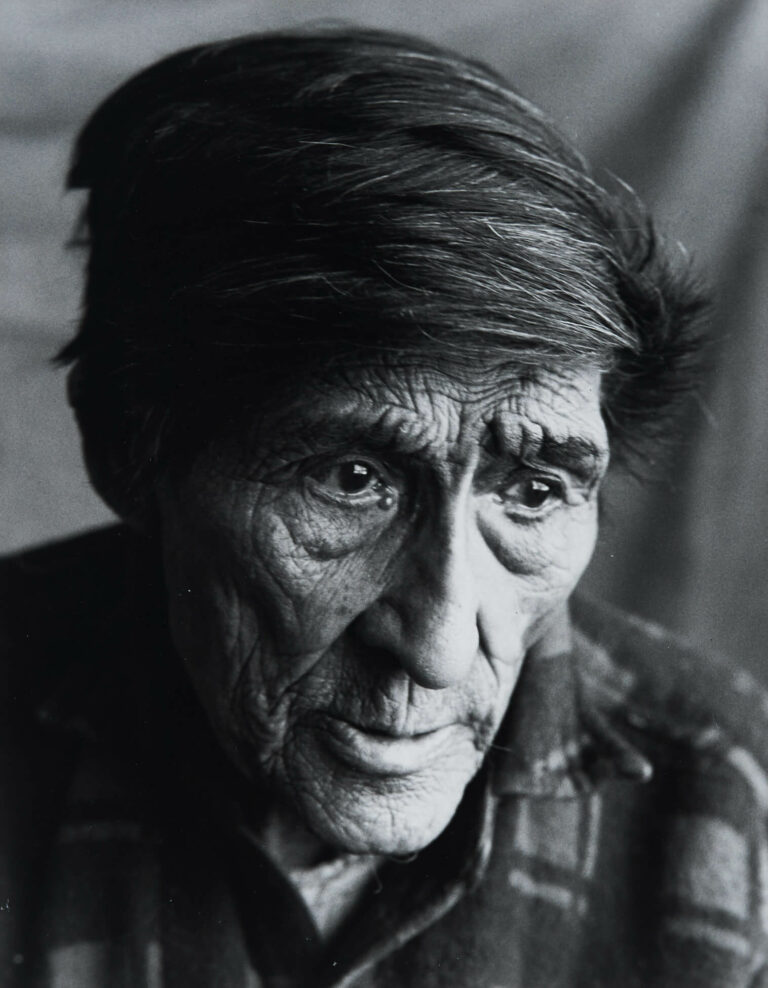
Born to Scots-Métis and Cree parents, McKenzie was raised in northern Manitoba. At age seventeen, he was sent to a sanatorium after contracting tuberculosis. His mother gave him a Brownie camera, which he used to photograph the other patients, and following this experience, he took a photography course by correspondence. While working other jobs, McKenzie continued to photograph Indigenous people and their ways of life, exhibiting, selling images to news organizations such as the Winnipeg Free Press, and collaborating on a book about northern Manitoba. In 1985 he became the first board president of the Native Indian / Inuit Photographers’ Association (NIIPA). His work toured as part of the first group exhibition, Visions, 1985, and as part of the second exhibition and book project, Silver Drum, 1986, which placed four contemporary photographers in dialogue with the work of the late George Johnston. For Visions, McKenzie offered this artist statement: “Photography affirms and poses questions of a community, thus playing an important role in community development. I believe strongly that photographs by Indians can reflect our unique view of the world. Not only is it possible, but it is our duty.”
Murray McKenzie, Daniel Spence, Lonesome Trapper, age 102, 1984, black and white photograph, image: 36.5 x 28.5 cm, Crown-Indigenous Relations and Northern Affairs Canada, Gatineau.
For further reading, see:
Chartrand, Rhéanne. “Why Not Hamilton? Shining Light on the Creation of the Native Indian/Inuit Photographers’ Association.” Building Cultural Legacies Hamilton, 2018. buildingculturallegacies.ca/artist/native-indian-inuit-photographers-association-niipa/.
Hill, Richard, and Sandra Semchuk. Silver Drum: Five Native Photographers; George Johnston, Dorothy Chocolate, Richard Hill, Murray McKenzie, Jolene Rickard. Hamilton: Native Indian / Inuit Photographers’ Association / NIIPA, 1986.
Legault, Paul, et al. “Murray McKenzie Exhibition.” Heritage North Museum, n.d. epe.lac-bac.gc.ca/100/205/301/ic/cdc/nilhinimuk/mainframe.htm.
Lowery, Bob. The Unbeatable Breed: People and Events in Northern Manitoba. Winnipeg: Prairie Publishing, 1981.
McKenzie, Murray. “Artist’s Statement.” In Visions: From Contemporary Native Photographers, 29. Hamilton: The Native Indian/Inuit Photographers’ Association, 1986.
Rozyk, Amanda. “Murray McKenzie (1927–2007).” Gabriel Dumont Institute of Native Studies and Applied Research, May 2009. www.metismuseum.ca/resource.php/11395

-
Minden, Robert (b.1941, Toronto)
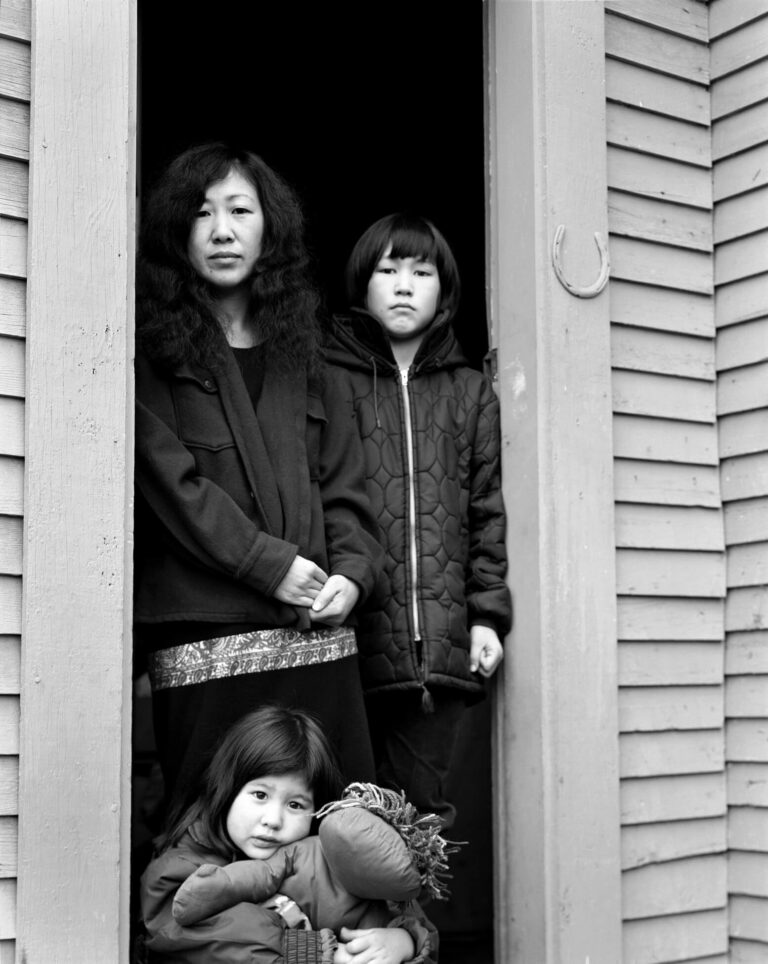
Robert Minden is a sociologist, musician, and photographer based in Vancouver. He is known for his documentary photographs from the 1970s and 1980s of the dispossessed Doukhobor communities in the Kootenays and the displaced Japanese Canadian community in the fishing village of Steveston, both in B.C. Minden collaborated with poet Daphne Marlatt on the now classic work Steveston, an evocation of the Japanese Canadian experience at the mouth of the Fraser River.
Image: Robert Minden, Tsuneko and her children, Aaron and Gen, 1974, gelatin silver print, Collection of the artist.
For further reading, see:
Marlatt, Daphne (author), and Robert Minden (photographer). Steveston.
Minden, Robert. Separate from the World: Meetings with Doukhobor-Canadians in British Columbia / A l’écart du reste du monde : conversations avec des Doukhobors canadiens de la Colombie-Britannique. Vancouver: National Film Board of Canada, 1979.

-
Moser, Lida (1920, New York–2014, Washington, D.C.)
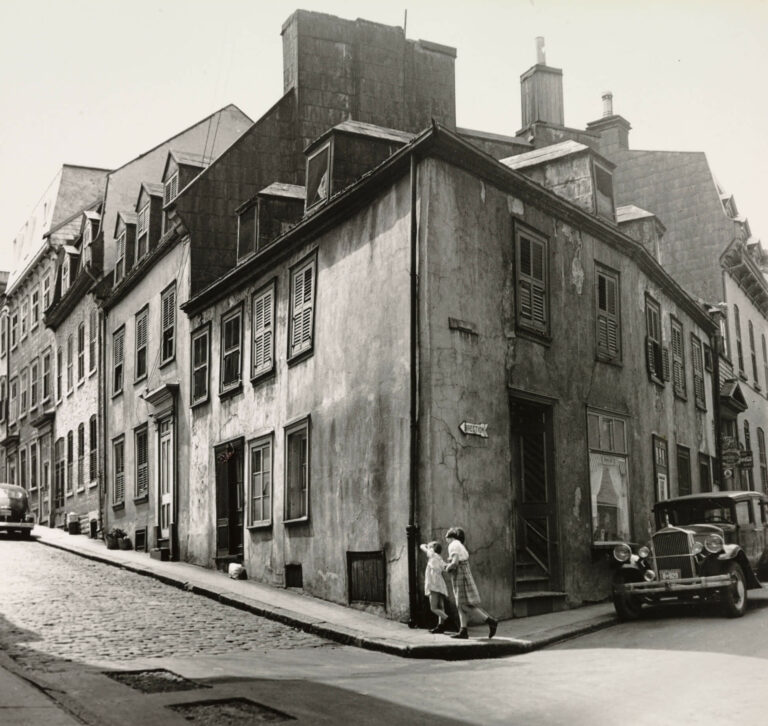
Lida Moser was a freelance photographer who began her career in New York during the 1940s. She apprenticed with photographer Berenice Abbott and was a member of New York’s Photo League. In the summer of 1950, Vogue magazine hired Moser to report on Canada. She met Paul Gouin, cultural advisor to Quebec premier Maurice Duplessis, and accompanied him on a government-sponsored tour of the province. During this visit and on a subsequent assignment for Look magazine, Moser photographed the people and architecture of Quebec, focusing on distinctive features of rural life. Moser had a long career as a commercial photographer and wrote several books about how to succeed in the field.
Image: Lida Moser, At the intersection of Saint-Flavien and Couillard streets, Québec, 1950, gelatin silver print, 26.8 x 28.6 cm, Musée national des beaux-arts du Québec, Quebec City.
For further reading, see:
Bouchard, Anne-Marie. 1950 : le Québec de la photojournaliste américaine Lida Moser. Quebec City: Musée national des beaux-arts du Québec, 2015, 10-11.
Lee, Elizabeth. “Looking for Lida Moser.” In A Lens without Limits: The Photography of Lida Moser, edited by Elizabeth Lee, Jacqueline Hochheiser, Kate Marra, and Monica Skelly, 6. Carlisle: Trout Gallery and Dickinson College, 2018.
Moser, Lida. Career Photography: How to Be a Success as a Professional Photographer. Hoboken: Prentice Hall, 1983.
———. Grants in Photography: How to Get Them. Garden City: Amphoto, 1978.

-
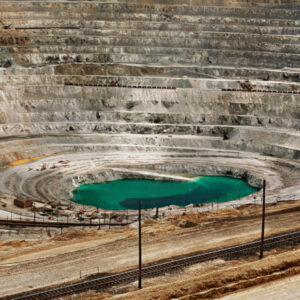 About the Authors
About the Authors
This book is written by art historians Sarah Bassnett and Sarah Parsons.
-
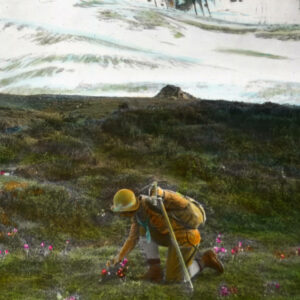 More Online Art Books
More Online Art Books
Read online or download the ACI’s incredible library of art books for free in French and English.
-
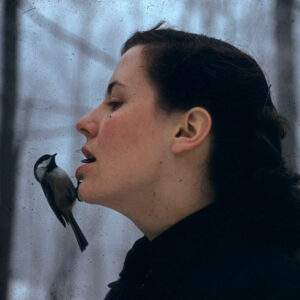 Preface
Preface
Photography has become so thoroughly integrated into our everyday experience that it may be hard to imagine life without it.
